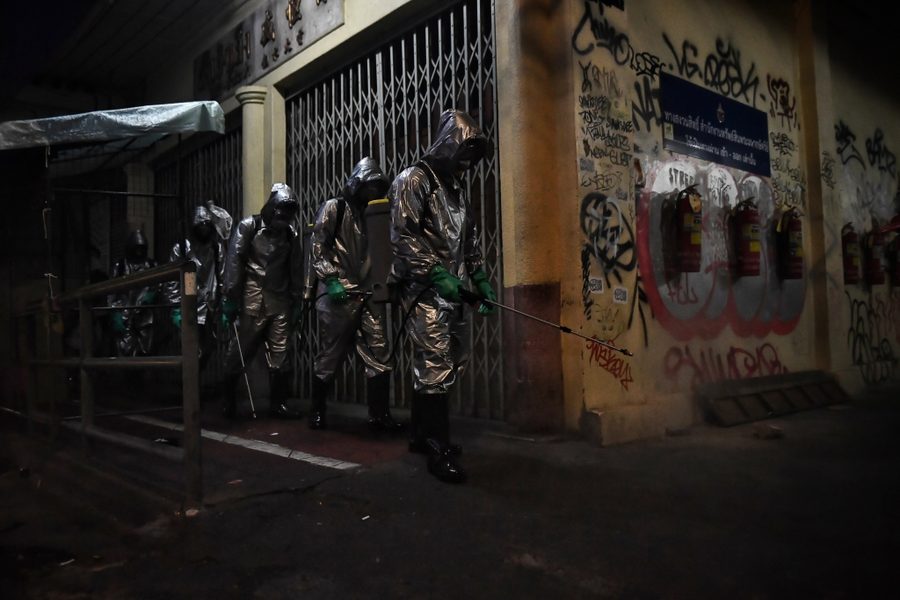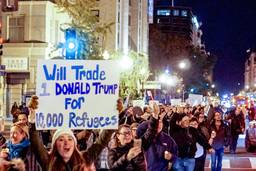Mike Davis: The Coronavirus Crisis Is a Monster Fueled by Capitalism
Pandora’s Box is open, and our ruthless economic system is making everything far worse.
Mike Davis

Coronavirus is the old movie that we’ve been watching over and over again since Richard Preston’s 1995 book The Hot Zone introduced us to the exterminating demon, born in a mysterious bat cave in Central Africa, known as Ebola. It was only the first in a succession of new diseases erupting in the ‘virgin field’ (that’s the proper term) of humanity’s inexperienced immune systems. Ebola was soon followed by avian influenza, which jumped to humans in 1997, and SARS which emerged at the end of 2002. Both cases appeared first in Guangdong, the world’s manufacturing hub.
Hollywood, of course, lustfully embraced these outbreaks and produced a score of films to titillate and scare us. (Steven Soderbergh’s Contagion, released in 2011, stands out for its accurate science and eerie anticipation of the current chaos.) In addition to the films and innumerable lurid novels, hundreds of serious books and thousands of scientific articles have responded to each outbreak, many emphasizing the appalling state of global preparedness to detect and respond to such novel diseases.
A new monster
So Corona walks through the front door as a familiar monster. Sequencing its genome (very similar to its well-studied sister SARS) was a piece of cake, yet much information is still missing. As researchers work night and day to characterize the outbreak they are faced with three major challenges. First, the continuing shortage of test kits, especially in the United States and Africa, has prevented accurate estimates of key parameters such as reproduction rate, size of infected population and number of benign infections. The result has been a chaos of numbers.
Second, like annual influenzas, this virus is mutating as it courses through populations with different age compositions and health conditions. The variety that Americans are most likely to contract is already slightly different from that of the original outbreak in Wuhan. Further mutation could be benign or could alter the current distribution of virulence which spikes sharply after age 50. The coronavirus is at minimum a mortal danger to Americans who are elderly, have weak immune systems, or chronic respiratory problems.
Third, even if the virus remains stable and little mutated, its impact on younger age cohorts could differ radically in poor countries and amongst high poverty groups. Consider the global experience of the Spanish flu in 1918-19 which is estimated to have killed 1 to 3% of humanity. In the United States and Western Europe, H1N1 was most deadly to young adults. This has usually been explained as a result of their relatively stronger immune systems which overreacted to the infection by attacking lung cells, leading to pneumonia and septic shock.
In any event, the influenza found a favored niche in army camps and battlefield trenches where it scythed down young soldiers by the tens of thousands. This became a major factor in the battle of empires. The collapse of the great German spring offensive of 1918, and thus the outcome of the war, has been attributed by some to the fact that the Allies, in contrast to their enemy, could replenish their sick armies with newly arrived American troops.
But the Spanish flu in poorer countries had a different profile. It’s rarely appreciated that a major proportion of global mortality occurred in the Punjab, Bombay and other parts of Western India where grain exports to Britain and brutal requisitioning practices coincided with a major drought. Resultant food shortages drove scores of poor people to the edge of starvation. They became victims of a sinister synergy between malnutrition — which suppressed their immune response to infection and produced rampant bacterial — as well as viral pneumonia.
This history — especially the unknown consequences of interactions with malnutrition and existing infections — should warn us that COVID-19 might take a different and more deadly path in the dense, sickly slums of Africa and South Asia. With cases now appearing in Lagos, Kigali, Addis Ababa and Kinshasa, no one knows (and won’t know for a long time because of the absence of testing) how it may interact with local health conditions and diseases. Some have claimed that because the urban population of Africa is the world’s youngest, the pandemic will only have a mild impact. In light of the 1918 experience, this is a foolish extrapolation. As is the assumption that the pandemic, like seasonal flu, will recede with warmer weather.
The legacy of austerity
A year from now we may look back in admiration at China’s success in containing the pandemic but in horror at the United States’ failure. The inability of our institutions to keep Pandora’s Box closed, of course, is hardly a surprise. Since at least 2000 we’ve repeatedly seen breakdowns in frontline healthcare.
Both the 2009 and 2018 flu seasons, for instance, overwhelmed hospitals across the country, exposing the shocking shortage of hospital beds after years of profit-driven cutbacks of in-patient capacity. The crisis dates back to the corporate offensive that brought Ronald Reagan to power and converted leading Democrats into its neoliberal mouthpieces. According to the American Hospital Association, the number of in-patient hospital beds declined by an extraordinary 39% between 1981 and 1999. The purpose was to raise profits by increasing ‘census’ (the number of occupied beds). But management’s goal of 90% occupancy meant that hospitals no longer had the capacity to absorb patient influx during epidemics and medical emergencies.
In the new century, emergency medicine has continued to be downsized in the private sector by the ‘shareholder value’ imperative of increasing short-term dividends and profits, and in the public sector by fiscal austerity and reductions in state and federal preparedness budgets. As a result, there are only 45,000 ICU beds available to deal with the projected flood of serious and critical Corona cases. (By comparison, South Koreans have more than three times more beds available per thousand people than Americans.) According to an investigation by USA Today “only eight states would have enough hospital beds to treat the 1 million Americans 60 and over who could become ill with COVID-19.”
At the same time, Republicans have repulsed all efforts to rebuild safety nets shredded by the 2008 recession budget cuts. Local and state health departments — the vital first line of defense — have 25% less staff today than they did before Black Monday twelve years ago. Over the last decade, moreover, the CDC’s budget has fallen 10% in real terms. Under Trump, the fiscal shortfalls have only been exacerbated. The New York Times recently reported that “21 percent of local health departments reported reductions in budgets for the 2017 fiscal year.” Trump also closed the White House pandemic office, a directorate established by Obama after the 2014 Ebola outbreak to ensure a rapid and well-coordinated national response to new epidemics.
We are in the early stages of a medical version of Hurricane Katrina. After disinvesting in emergency medical preparedness at the same time that all expert opinion has recommended a major expansion of capacity, we lack basic low-tech supplies as well as respirators and emergency beds. National and regional stockpiles have been maintained at levels far below what is indicated by epidemic models. So the test kit debacle has coincided with a critical shortage of protective equipment for health workers. Militant nurses, our national social conscience, are making sure that we all understand the grave dangers created by inadequate stockpiles of protective supplies like N95 face masks. They also remind us that hospitals have become greenhouses for antibiotic-resistant superbugs such as S. aureus and C. difficile which may become major secondary killers in overcrowded hospital wards.
An unequal crisis
The outbreak has instantly exposed the stark class divide in American healthcare. Those with good health plans who can also work or teach from home are comfortably isolated provided they follow prudent safeguards. Public employees and other groups of unionized workers with decent coverage will have to make difficult choices between income and protection. Meanwhile, millions of low-wage service workers, farm employees, the unemployed and the homeless are being thrown to the wolves.
As we all know, universal coverage in any meaningful sense requires universal provision for paid sick days. A full 45% of the workforce is currently denied that right and virtually compelled to either transmit the infection or set an empty plate. Likewise, 14 states have refused to enact the provision of the Affordable Care Act that expands Medicaid to the working poor. That’s why nearly one in five Texans, for instance, lacks coverage.
The deadly contradictions of private healthcare in a time of plague are most visible in the for-profit nursing home industry which warehouses 1.5 million elderly Americans, most of them on Medicare. It is a highly competitive industry capitalized on low wages, understaffing and illegal cost-cutting. Tens of thousands die every year from long-term care facilities’ neglect of basic infection control procedures and from governments’ failure to hold management accountable for what can only be described as deliberate manslaughter. Many of these homes find it cheaper to pay fines for sanitary violations than to hire additional staff and provide them with proper training.
It’s not surprising that the first epicenter of community transmission was the Life Care Center, a nursing home in the Seattle suburb of Kirkland. I spoke to Jim Straub, an old friend who is a union organizer in Seattle area nursing homes. He characterized the facility as “one of the worst staffed in the state” and the entire Washington nursing home system “as the most underfunded in the country — an absurd oasis of austere suffering in a sea of tech money.”
Straub pointed out that public health officials were overlooking the crucial factor that explains the rapid transmission of the disease from Life Care Center to nine other nearby nursing homes: “Nursing home workers in the priciest rental market in America universally work multiple jobs, usually at multiple nursing homes.” He says that authorities failed to find out the names and locations of these second jobs and thus lost all control over the spread of COVID-19.
Across the country, many more nursing homes will become coronavirus hotspots. Many workers will eventually choose the food bank over working under such conditions and stay home. In this case, the system could collapse — and we shouldn’t expect the National Guard to empty bedpans.
The way forward
The pandemic illustrates the case for universal health coverage and paid leave with every step of its deadly advance. While Joe Biden will likely face off against Trump in the general election, progressives must unite, as Bernie Sanders proposes, to win Medicare for All. The combined Sanders and Warren delegates have one role to play at the Milwaukee Democratic National Convention in July, but the rest of us have an equally important role in the streets, starting now with the fights against evictions, layoffs, and employers who refuse compensation to workers on leave.
But universal coverage and associated demands are only a first step. It’s disappointing that in the primary debates neither Sanders nor Warren highlighted Big Pharma’s abdication of the research and development of new antibiotics and antivirals. Of the 18 largest pharmaceutical companies, 15 have totally abandoned the field. Heart medicines, addictive tranquilizers and treatments for male impotence are profit leaders, not the defenses against hospital infections, emergent diseases and traditional tropical killers. A universal vaccine for influenza — that is to say, a vaccine that targets the immutable parts of the virus’s surface proteins — has been a possibility for decades, but never deemed profitable enough to be a priority.
As the antibiotic revolution is rolled back, old diseases will reappear alongside novel infections and hospitals will become charnel houses. Even Trump can opportunistically rail against absurd prescription costs, but we need a bolder vision that looks to break up the drug monopolies and provide for the public production of lifeline medicines. (This used to be the case: during World War Two, Jonas Salk and other researchers were enlisted to develop the first flu vaccine.) As I wrote fifteen years ago in my book The Monster at Our Door—The Global Threat of Avian Flu:
Access to lifeline medicines, including vaccines, antibiotics, and antivirals, should be a human right, universally available at no cost. If markets can’t provide incentives to cheaply produce such drugs, then governments and non-profits should take responsibility for their manufacture and distribution. The survival of the poor must at all times be accounted a higher priority than the profits of Big Pharma.
The current pandemic expands the argument: capitalist globalization now appears biologically unsustainable in the absence of a truly international public health infrastructure. But such an infrastructure will never exist until peoples’ movements break the power of Big Pharma and for-profit healthcare.
This requires an independent socialist design for human survival that includes — but goes beyond — a Second New Deal. Since the days of Occupy, progressives have successfully placed the struggle against income and wealth inequality on page one — a great achievement. But now socialists must take the next step and, with the healthcare and pharmaceutical industries as immediate targets, advocate social ownership and the democratization of economic power.
We must also make an honest evaluation of our political and moral weaknesses. The leftward evolution of a new generation and the return of the word ‘socialism’ to political discourse cheers us all, but there’s a disturbing element of national solipsism in the progressive movement that is symmetrical with the new nationalism. We talk only about the American working class and America’s radical history (perhaps forgetting that Eugene V. Debs was an internationalist to the core).
In addressing the pandemic, socialists should find every occasion to remind others of the urgency of international solidarity. Concretely we need to agitate our progressive friends and their political idols to demand a massive scaling up of the production of test kits, protective supplies and lifeline drugs for free distribution to poor countries. It’s up to us to ensure that ensuring universal, high-quality healthcare becomes foreign as well as domestic policy.
A version of this piece first appeared at Jacobin.





